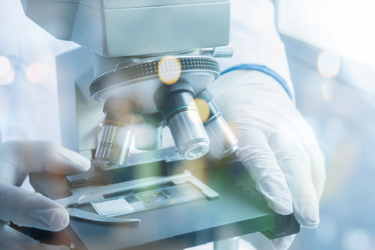How Microscopy Helps Big Pharma With The Little Things

By John Oncea, Editor

Microscopy plays a crucial role in various aspects of pharmaceutical research and development within life sciences. Let’s take a look at how Big Pharma uses this technology to discover new drugs, perform quality control, and more.
Microscopy in life sciences supports various stages of drug development, from the early discovery phase to quality control and safety assessment. It enables scientists to visualize and understand the complex interactions between drugs and biological systems, aiding in the development of safer and more effective medications.
Microscopy is, by definition, a lot of things. In the simplest of terms, it is “the technical field of using microscopes to view samples and objects that cannot be seen with the unaided eye (objects that are not within the resolution range of the normal eye),” according to Edinburgh Imaging.
This is, of course, done through the use of microscopes whose use, according to Science Learning Hub, may date back as far as 700 BC when the Nimrud lens, a piece of rock crystal, could have been used as a magnifying glass or as a burning glass to start fires by concentrating sunlight. An early version of the compound microscope came in 1590 when Zacharias Janssen and his son Hans placed multiple lenses in a tube, observing that viewed objects in front of the tube appeared enlarged.
Thirty-five years later, in 1625, Giovanni Faber coined the name ‘microscope’ to describe Galileo Galilei’s device created 16 years prior. Modifications and advancements come over the years culminating with the Nobel Prize in Physics being awarded jointly to Ernst Ruska (for his work on the electron microscope) and Gerd Binnig and Heinrich Rohrer (for the scanning tunneling microscope) in 1986, as well as the Nobel Prize in Chemistry awarded in 2014 to Eric Betzig, Stefan Hell, and William Moerner for the development of super-resolved fluorescence microscopy which allows microscopes to now ‘see’ matter smaller than 0.2 micrometers.
Understanding Life Sciences
Life sciences is a term referring to businesses, organizations, and research organizations dedicated to protecting and improving organism life according to Straits Research. This includes biomedicine, pharmaceuticals, biophysics, neuroscience, cell biology, biotechnology, nutraceuticals, food processing, cosmeceuticals, life systems technologies, environmental sciences, and more.
The microscopic techniques discussed earlier have significantly developed over the past 20 years and now provide an indispensable tool to the life sciences industry. This includes drug development where they’re used to visualize drug interactions with cells, tissues, or pathogens. Techniques used include:
- Light Microscopy: This uses visible light to illuminate samples. It includes techniques like bright-field microscopy (basic observation), phase-contrast microscopy (enhanced contrast), fluorescence microscopy (visualizing fluorescently labeled molecules), and confocal microscopy (optical sectioning for 3D imaging).
Fluorescence is of critical importance in the modern life sciences as it can be extremely sensitive, allowing the detection of single molecules. Many fluorescent dyes can be used to stain structures or chemical compounds. One powerful method is the combination of antibodies coupled to a fluorophore as in immunostaining. Examples of commonly used fluorophores are fluorescein or rhodamine.
- Electron Microscopy: This involves using a beam of electrons to create images at a much higher resolution than light microscopy. Transmission Electron Microscopy (TEM) and Scanning Electron Microscopy (SEM) are common techniques used for detailed imaging of cellular structures and surfaces.
- Super-Resolution Microscopy: These techniques surpass the diffraction limit of light, allowing higher resolution than traditional light microscopy. Examples include STED (Stimulated Emission Depletion) microscopy, PALM (Photoactivated Localization Microscopy), and STORM (Stochastic Optical Reconstruction Microscopy).
Microscopy’s contribution to life sciences includes drug discovery which helps in identifying and characterizing new drug targets, understanding cellular mechanisms, and observing the interactions between drugs and their targets at a microscopic level. It is also used for visualizing cellular structures and processes, enabling scientists to study the effects of drugs on cells. This includes observing how drugs interact with cell membranes, organelles, and proteins.
Another area in which microscopy is utilized is quality control, specifically particle analysis, when used to inspect raw materials, drug formulations, and finished products for any contamination or irregularities, ensuring quality and compliance with regulatory standards. It also can be used in crystallization studies to help understand how substances crystallize and the properties of those crystals by analyzing crystalline structures for stability and efficacy.
Pharmacokinetics and pharmacodynamics are two other life sciences techniques benefitting from microscopy, first in drug delivery systems where it assists in studying drug delivery mechanisms, such as nanoparticles, liposomes, and microcapsules. Observing how these systems interact with cells/tissues helps optimize drug delivery. In addition, microscopy aids in visualizing how drugs interact with tissues and organs, enabling a better understanding of their effects and distribution in the body in both preclinical and clinical studies.
Four additional uses of microscopy in life sciences are:
- Pathological Studies: Microscopy allows for detailed examination of diseased tissues and cells, aiding in understanding disease mechanisms, identifying biomarkers, and developing targeted therapies.
- Molecular Imaging: Fluorescence and confocal microscopy help visualize molecular events, such as protein-protein interactions or gene expression, contributing to the development of precision medicine.
- Toxicology Studies: Microscopy is used to assess the effects of drugs on tissues and organs, identifying potential toxicities or side effects during preclinical and clinical trials.
- Cellular and Histological Analysis: Studying cellular changes caused by drugs helps assess their safety profiles and potential adverse effects.
